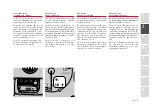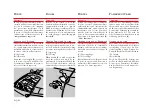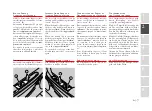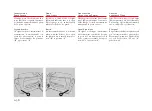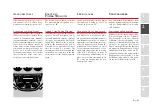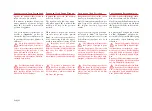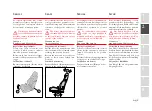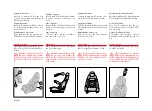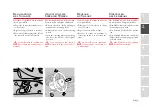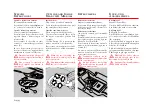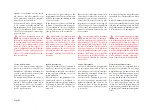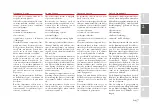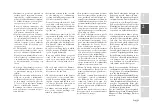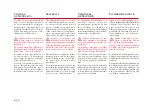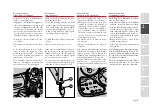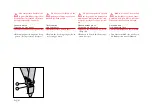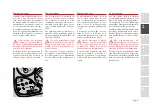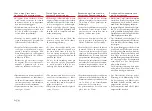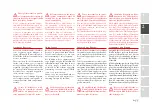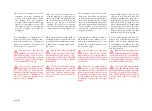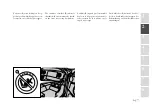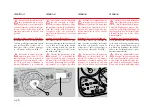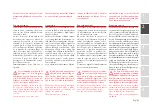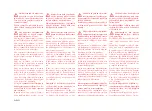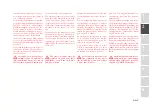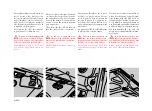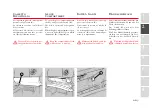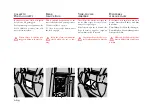
2.49
1
2
3
4
5
6
7
8
• Impianti in pressione presenti in
vettura quali: impianto frenante,
impianto di condizionamento, im-
pianto di raffreddamento e impian-
to di lubrificazione, possono gene-
rare pressioni al loro interno.
Evitare qualsiasi intervento che
possa causare la fuoriuscita di gas
o liquidi con il rischio di lesioni
alle persone e danni alle cose.
• Il gas di scarico generato dal moto-
re in funzione può essere pericolo-
so specialmente all’interno di un
locale chiuso. Il motore oltre a con-
sumare ossigeno scarica anidride
carbonica, ossido di carbonio e al-
tri gas tossici.
• Il combustibile oltre ad emettere
vapori che se inalati possono essere
nocivi, è altamente infiammabile.
Non avvicinare fiamme libere o scin-
tille al serbatoio carburante aperto
o in qualsiasi altra situazione in cui
vi sia combustibile a contatto con
l’aria.
• Anche gli oli utilizzati possono es-
sere infiammabili utilizzare le stes-
se precauzioni come per il combu-
stibile.
• Il liquido contenuto nella batteria è
velenoso, corrosivo e infiammabi-
le. Evitare che fuoriesca e che ven-
ga in contatto con la pelle, gli occhi
o le cose. Non avvicinare fiamme
libere o scintille alla batteria.
È comunque necessario osservare le
varie avvertenze contenute nel pre-
sente libretto.
• Mit Druck arbeitende Anlagen im
Fahrzeug, wie z.B. Brems-, Klima-,
Kühl- und Schmieranlage können
in ihrem Inneren Druck entwickeln.
Jegliche Art von Eingriff vermei-
den, der das Austreten von Gas oder
Flüssigkeiten hervorrufen könnte, da
dies zu Verletzungsrisiken für Per-
sonen und zu Sachschäden führt.
• Die vom laufenden Motor erzeug-
ten Abgase können insbesondere in
einem geschlossenen Raum gefähr-
lich sein. Der Motor verbraucht
Sauerstoff und gibt Kohlendioxyd,
Kohlenmonoxyd und andere gifti-
ge Gase ab.
• Der Kraftstoff ist hoch entflamm-
bar und gibt Dämpfe ab, deren Ein-
atmen zu Vergiftungen führen kann.
Keine Flammen oder Funken in die
Nähe des offenen Kraftstoffbehäl-
ters bringen, bzw. nie in Situatio-
nen benutzen, in denen Kraftstoff
in Kontakt mit der Luft gerät.
• Auch die verwendeten Öle können
entflammbar sein, daher gelten hier
die gleichen Vorsichtsmaßnahmen
wie für den Kraftstoff.
• Die in der Batterie befindliche Flüssig-
keit ist giftig, ätzend und entflamm-
bar. Ihr Austreten vermeiden, ebenso
ihren Kontakt mit der Haut, den Au-
gen oder Gegenständen. Keine offe-
nen Flammen oder Funken in die Nähe
der Batterie geraten lassen.
Die verschiedenen, im vorliegenden
Handbuch gegebenen Warnungen und
Hinweise sollten unbedingt beachtet
werden.
• Pressurized systems in the car such
as the braking, air conditioning,
cooling and lubricating systems can
all create internal pressure.
Do not let any work be done on the
car which could lead to gas or liq-
uids leaking since this could harm
the people in the vicinity and dam-
age the car.
• The exhaust gas generated by the
engine when running could be dan-
gerous, especially in a confined
space. As well as consuming oxy-
gen, the engine also discharges car-
bon dioxide, carbon monoxide and
other noxious gases.
• As well as emitting vapours which
may be noxious if inhaled, the fuel
is also highly flammable.
Keep any naked flames or sparks
clear of the fuel tank when it is
open or in any situation in which
the fuel is in contact with the air.
• The oils used can also be flamma-
ble and so the same precautions are
necessary as for the fuel.
• The liquid contained in the battery
is poisonous, corrosive and flam-
mable. Prevent it leaking and com-
ing into contact with the skin, eyes
or objects. Keep the battery away
from naked flames or sparks.
It is always necessary though to take
note of the various warnings con-
tained in this manual.
• Des systèmes sous pression présents
dans la voiture tels que système frei-
nant, système d’air conditionné, sys-
tème de refroidissement et système de
lubrification peuvent provoquer des
pressions internes à leur propre système.
Eviter toute intervention qui pour-
rait provoquer la fuite de gaz ou de
liquide pouvant porter atteinte aux
personnes ou objets.
• Le gaz d’échappement émis par le
moteur en marche peut être dange-
reux surtout en espace clos. Le moteur,
non seulement consomme de l’oxy-
gène, mais émet aussi de l’anhydride
de carbonique, de l’oxyde de car-
bone et autres gaz toxiques.
• Le combustible, non seulement émet
des vapeurs qui, si elles sont inha-
lées peuvent s’avérer dangereuses,
mais est aussi très inflammable.
Ne pas approcher de flammes libres
ou des étincelles vers le réservoir à
carburant ouvert ou en quelques
autres situations où le combustible
viendrait en contact avec l’air.
• Même les huiles utilisées peuvent
être inflammables. Respecter les
mêmes précautions que pour le com-
bustible.
• Le liquide contenu dans la batterie
est toxique, corrosif et inflamma-
ble. Eviter qu’il ne se déverse et ne
vienne au contact de la peau, des
yeux ou d’objets. Ne pas placer la
batterie à proximité de flammes ou
d’étincelles.
Il est en tout état de cause nécessaire
de respecter les divers avertissements
décrits dans ce carnet.
Содержание 360 spider
Страница 1: ......
Страница 2: ......
Страница 8: ...8 Indice Summary Sommaire Inhaltsverzeichnis ...
Страница 218: ...7 15 1 2 3 4 5 6 7 8 14 18 17 13 1 2 6 10 2 6 10 9 8 20 19 15 14 21 24 4 4 22 11 5 5 12 3 7 21 18 17 13 1 23 16 8 9 ...
Страница 261: ...7 58 5 3 4 1 10 9 1 11 10 2 8 7 6 Impianto Elettrico Elektroanlage Système Electrique Electrical System ...
Страница 266: ...8 1 1 2 3 4 5 6 7 8 Indice degli Argomenti Table of Contents Table des Matières Inhaltsverzeichnis 8 2 8 4 8 6 8 8 ...
Страница 276: ......

